by James Kilgore
from Counterpunch, November 2013
 “This is the beginning of the end of mass incarceration.”
“This is the beginning of the end of mass incarceration.”
Natasha Frost, associate dean of Northeastern University’s school of criminology and criminal justice
After more than three decades of “tough on crime”, the New Jim Crow, truth in sentencing and three strikes, the law and order project looks adrift with no one rushing to bring it back on course. The bubble of prison construction is about to burst, if it hasn’t already. Pretty soon it may be difficult to find anyone who admits they once advocated serial prison building and trying fourteen year olds as adults. Crime figures are down while other distress meters rise into the danger zone- unemployment, homelessness, and deteriorating public education. No longer can Directors of Corrections masquerade as first responders and lay claim to unlimited funding streams. Budgetary and social justice alarm bells are ringing loud and clear. On top of this, as Soros Justice fellow Tracy Huling notes, a “newfound political will” from state Governors of both parties “to close prisons and, in some cases, to reduce the overall size of their incarceration systems” has emerged. At a local level, more than 40 municipalities and counties from, Kalamazoo to Jacksonville, have passed Ban the Box legislation which removes questions about criminal background from job applications. Even people with felony convictions seem to be getting a fair shake.
For those of us who have spent years of our lives in cages and for everyone who has been fighting mass incarceration, this reality is encouraging but also a little unsettling. We have perfected our mantras, honed our talking points of condemnation for everything from supermaxes to technical parole violations. Now everyone speaks like they are on our side. In a battle where the lines were once clearly drawn, the division between them and us is getting murky. After six and a half years inside Federal and state prisons, I’m getting pressure to call prison guards “correctional officers,” being told I must find commonality with them as “exploited workers.” Such urgings push me into an uncomfortable corner. Time to take a deep breath and survey the lay of the land.
The Carceral Big Picture
Capturing the big picture requires looking at several aspects of what some of us call the prison industrial complex. The first is the numbers game: do we really have less people behind bars? The answer is, yes. For the past three years, the total number of people in prisons in the US has fallen for the first time since 1972, a post-2009 decrease of about 43,000 out of a prison population of more than 1.5 million (2.2. million including jails). No massive celebrations are in order, however. Some disturbing new trends are creeping into the mix-like the meteoric increase in the incarceration of women in the last few years. Besides, even with the reductions, the US still far outdistances the rest of the world in per capita incarceration rates and states like Pennsylvania continue to promote massive prison construction projects.
Also, the numbers game isn’t everything. We need to ask what happens to people who have been taken out of prison. Do they find jobs? Are substance abuse and mental health treatment programs available? Are they managing to avoid constant harassment by police? Do they really have a future or are they destined to live at the margins, in the gutters, alleys and board ups of U.S. cities? And most importantly, how many of them are locked up somewhere else just to keep the state prison statistics looking good? Answering these questions is difficult. That trending catchall, “alternatives to incarceration,” can become a shell game where punitive policies submerge themselves in benevolent clouds of risk assessment tools and evidence-based practices. Punishment adopts many pseudonyms.
A quick snapshot of the nation’s four largest prison systems sheds considerable light on the complex dynamics involved. Let’s begin with the good news, New York, where the most significant changes have occurred. Since 1999 the prison population in New York State has decreased by 24% with eleven prisons closed. Law enforcement officials have been quick to attribute these shifts to reduced crime produced by “hot spot” policing and “zero tolerance.” Activists Judith Greene and Marc Mauer call the decreases the result of “a remarkable change in drug enforcement policy in 1999 that entailed an unprecedented curtailing of NYPD’s ‘war on drugs.’” These policy changes didn’t come about through a spontaneous change of heart by police, nor did legislators simply wake up to budgetary pressures. Rather, the work of civil society groups like the NYCLU, the Correctional Association’s “Drop the Rock” campaign, and the Drug Policy Alliance’s Real Reform coalition exposed the bankruptcy of aggressive drug prosecutions. Eventually the public and then key officials like District Attorney Joe Hynes began to see the light.
Reforms to laws such as the removal of mandatory minimum sentences, contributed to a decline in drug arrests, from 40,361 in 2008 to 29,960 in 2012. Moreover, while the stop and frisk policy has deservedly landed New York City with a New Jim Crow label, figures from the state Division of Criminal Justice Services show that Black drug arrests have actually been decreasing- from 42% of the total in 2008 to 35% in 2012. More people now receive citations for minor possession. In other cases, instead of offering penitentiary time, authorities channel thousands through treatment-based diversions like drug courts. Relaxing conditions of parole is also part of the new approach, precipitating a huge reduction in returns to prison for petty transgressions like missing a meeting with a parole agent or failing to look for work. Still, even with all these changes, New York State’s per capita incarceration rate remains at 425 per 100,000, well below the national average of 728 but about four times that of the United Kingdom and five times the rate in Sweden. Though New York has made great strides, forgiveness and mercy have not yet been thoroughly etched into the logo of the New York State Department of Corrections.
California
California presents another version of the reform scenario: a set of administrative changes forced down the throat of the governor by a Federal Court decision. Despite its reputation as a Blue state, California has been at the cutting edge of racialized mass incarceration. As recently as 2007, the state assembly voted 70-1 to pass AB 900 authorizing the construction of 53,000 new prison and jail “beds.” But a high profile campaign by Californians United for a Responsible Budget (CURB), a coalition of over 50 organizations and an advocacy heir of prison abolition pioneers Critical Resistance, slowed the state’s capacity to roll out the construction. Then in 2009 the Federal Courts intervened. In a landmark move resulting from legal action by prison resident Marciano Plata, the court upheld the plaintiff’s allegations that medical care in California’s prisons was inadequate. The decision pointed to overcrowding, rather than lack of services, as the root problem. The court then ordered the California Department of Corrections and Rehabilitation (CDCR) to slash the population from its then 200% of capacity to 137.5% within two years. Failure to comply would mean the Feds would step in and run the system.
In response, Jerry Brown, first as state Attorney-General, then as governor, bought time with legal appeals while he developed his plan of “realignment.” Vowing not to release people early, the Governor “realigned” individuals from the state prison system by shifting them into county jails and community-based programs. AB 109, passed in 2011, was the enabling legislation, removing the cap on county jail sentences and clearing the deck for people to serve unlimited time in county lockups as long as they were “non/non/nons” –non-serious, nonviolent, and non sexual. Despite disturbing results like one man being sentenced to 43 years in LA County Jail, Stanford law professor Joan Petersilia responded with typical Golden State hyperbole: “The importance of California’s realignment experiment cannot be overstated…This is the biggest penal experiment in modern history.”
This mega- “penal experiment” came with a local sweetener, extra funds for counties to accommodate the “realigned.” Some sheriffs opportunistically used this money for jail construction rather than placing people in alternative programs. A few prosecutors developed their own pushback strategy “upping ” the charges, to make sure a person’s conviction would warrant a prison rather than a jail sentence. Despite these obstructions, the plan succeeded in moving some 25,000 people out of the state system over the next two years, but fell short of the court-mandated target. Earlier this year, the Supreme Court issued a final verdict: the state had to reduce to 137.5% of capacity by the end of 2013. Brown then added a second round of “bonuses” to local authorities for his pass the buck strategy – $315 million in extra funding to county sheriffs to accommodate their new immigrants from CDCR with the figure to almost treble by 2015.
On the surface, Petersilia does seem to have a point – that the importance of this “cannot be overstated.” The issue is defining that importance. While Brown’s counter to the Feds has bounced thousands out of state prisons, medium- and long-term impact remain in doubt. As more money drifts down to the county level, more sheriffs may opt to expand jail capacity rather than fund programs. If this occurs, the net result could be no significant reduction in the ranks of the incarcerated but simply more people in county jails, less people in state prisons. This would be a clear cut loss for the men and women behind bars, since nearly any state prison, even California’s violent and racially segregated facilities where I spent a little over three years, offers programs and services vastly superior to those of most county jails.
On the other hand, if realignment were to succeed and keep reducing the number of people incarcerated in the Golden State, Governor Brown would have discovered a way of decarcerating by administrative fiat rather than a philosophical shift or significantly modifying draconian legislation and carceral practice.
Ultimately, the importance of Brown’s initiative may actually be in realigning the CDCR with private prison providers. While California has largely avoided private prisons, with Brown under the gun to reach the 137.5% by the end of 2013, the Governor signed an agreement with Corrections Corporation of America (CCA) to lease a minimum security facility in the Mojave Desert which holds 2300 beds. While the privates generally are staunchly anti-union, the deal allegedly would staff the facility with guards from the ultra-right union, California Correctional and Parole Officers Association (CCPOA), a major backer of Brown’s campaign.
In the meantime, CURB and many other groups continue to pressure against any expansion of the CDCR’s capacity, consistently calling for the release of people with non-violent cases as a more meaningful alternative than Brown’s administrative restructuring.
California’s process demonstrates how decarceration is about far more than numbers. The recent hunger strike by men in the Security Housing Unit in Pelican Bay provides evidence that the punishment paradigm remains alive and well in California. Brown and CDCR officials’ steadfast refusal to negotiate with hunger strikers who were demanding an end to isolation cells in which some of them had remained for over four decades, revealed that little had been realigned in the minds of criminal justice authorities in the Golden State. Only continued pressure from below by organizations like CURB is likely to yield more permanent results.
Texas
The upbeat version of recent criminal justice history in Texas characterizes the state as a poster child early adopter of prison reform. The narrative goes like this: when 2007 budget projections showed Texas would need 17,000 prison beds in the next five years at a cost of $1.6 billion, a now –retired, cherry Red state legislator named Jerry Madden stepped in. A series of startling reforms ensued – including the spread of drug courts, mental health and substance abuse treatment and lower parole case loads. The resulting changes freed up some 12,000 “beds” in the state system, though Texas continued to carry out contracts with more than a dozen private prisons.
In policy terms Texas, once the beacon for the “make my day” set , did soften, especially when it came to releasing people on parole. In addition, a broad-based coalition which included the ACLU of Texas, Grassroots Leadership, the Texas Criminal Justice Coalition, AFSCME Local 3807, the Texas Inmate Families Association and several other groups successfully foiled attempts at private prison expansion. While the state managed to free up enough “bed space” to close two institutions, a look at the overall numbers is equivocal. Texas did register a decrease of almost 3,000 people in the state prison system from 2011 to 2012, but the numbers remain at 2005 levels of slightly over 152,000, still the US’largest state prison system. Furthermore, with an astronomical per capita incarceration rate of 923 per 100,000, Texas doesn’t amount just yet to any beacon of hope. As a recent post from high profile blogger “Grits for Breakfast” asks: “If Texas justice reforms were so great, why does the state still have the nation’s largest prison population?” Good question.
Where Texas has succeeded is juvenile justice. After a set of scandals involving abuse of youth in state lockups in 2007, authorities closed nine facilities and built community-based alternatives. Perhaps adult corrections officials should study their juvenile counterparts more seriously.
The Federal System
Lastly, we come to the Federal system-the nation’s key carceral growth area. Despite the recent chest-beating by Attorney General Eric Holder about setting aside mandatory minimums, the Federal Bureau of Prisons(BOP) has not succumbed even to the rhetoric of decarceration, let alone the practice. Instead, the Feds have adopted an expansion-oriented business model, partnering with private prisons to tap into the “niche market” of immigration detention leading to an 84% rise in the number of people in immigration detention since 2005. In addition, Congress has imposed a mandatory quota of 34,000 immigration detainees- ICE cannot let the number fall below that figure, despite declines in actual “illegal” border crossings. Coupled with harsher immigration laws like Arizona’s SB 1070, all this has led to a spiking of deportations, with 2012 numbers surpassing 400,000 for the first time in history. In a previous Counterpunch article, I have termed this wave of deportations “The New Operation Wetback”, after an actual US government program in the 1950s which repatriated hundreds of thousands to Mexico. But nowadays deportation is not the only issue.
Under the current regime people with a prior illegal entry conviction can be sentenced to up to two years in prison before being repatriated. Those with a previous felony conviction who enter the US illegally can receive up to ten years, 20 years if it was an “aggravated felony. Locking up the undocumented has become the primary face of mass incarceration with the Feds leading the charge. The outcome has produced a drastic change in the demographics of those in prison. Since 2000, the number of African Americans in prison has actually fallen slightly but the ranks of “Hispanics” have increased by more than 50%. This has provided a lifeline for an almost moribund private corrections sector. While the privates control only 8% of the “beds” in the system nationwide, in the immigration detention sector they own and/or operate roughly half of the “beds.” Although the rate of African American incarceration remains about 50% higher than that of “Hispanics” the large-scale operations of mass incarceration may increasingly be led by the troops of Immigration and Customs Enforcement (ICE) rather than drug squads or SWAT teams.
Conclusion
In New York a popular mobilization along with politicians waking up to fiscal realities helped precipitate important changes. In Texas and California, the results have been much more uneven with political pushback and bureaucratic manipulations like realignment stalling comprehensive shifts. While the national and state level conversation has altered, we stand at the precipice of a very complex period- the bursting of the bubble of prison construction can assume many forms. Tracy Huling points out some of her concerns in this regard: I am worried that … entrenched special interests, including unions representing prison workers and for-profit private prison companies, might somehow combine to create the perfect storm.
Citing California Governor Brown’s dealings with private prison kingpin CCA, Huling goes on to add, “In that kind of scenario, given the extent to which campaign contributions and other kinds of bribes already corrupt the democratic process, all rational public policy considerations about the costs and benefits of prisons might be thrown out the window.”
A key point which grows from Huling’s analysis is that significantly changing the prison industrial complex entails wresting money and resources from corrections for programs and ultimately transformative processes that attack the problem at its core. In short, there is no stopping mass incarceration without redistribution of wealth and tax revenue, without attacking poverty and inequality.
Those who have benefited from mass incarceration will find new ways to resist change, new ways to brand and deliver their commodity. In 2010 private prison operator the GEO Group, bought the nation’s largest electronic monitoring firm, BI Incorporated. Clearly, GEO Group CEO George Zoley, who earned $7 million in 2010, thinks that GPS is part of the wave of the future. In a society where many people look for technological solutions to social problems, electronic home incarceration, especially as the surveillance capacity of GPS escalates, offers many attractive possibilities for investors and corrections power brokers. If prison and jails cells are rendered too costly, with home detention, families can shoulder the expense of room and board and the state can extract daily user fees for being monitored. Most programs already impose such user fees, typically from $5 to $17 a day.
Boutique prisons constitute a second reform which can sustain or expand incarceration. Not all forms of carceral punishment come with orange jumpsuits and electrified fences. Now we have a range of product variations designed to “humanize” the captive experience: “gender-responsive” institutions (which were part of Brown’s realignment), mental health lockups (the GEO Group has also heavily invested here), and family friendly immigration detention centers where mothers and fathers do time with their children while awaiting adjudication. And lastly, in a society predicated on dividing the rich from the poor, we have the pay to stay facilities where folks in Beverly Hills or Anaheim can fork out $150 a night not to have to sleep with the riff raff. All of these “alternatives” keep the resources and the focus on detention and deprivation.
Ultimately, the reversal of mass incarceration necessitates not only designing genuine alternatives but transforming the dominant national mindset. Perhaps the biggest challenge to current thinking relates to notions of innocence and guilt. Often when I speak to people about decarceration or ending prison construction, they accuse me of advocating for the release of Charles Manson or backing drive by shootings in inner city communities. But hundreds of thousands of people behind bars fall between the “non-non-nons” and the Mansons. They should be released long before their ridiculously long sentences have expired.
These people and their families are the major victims of mass incarceration. They carry the violent label in a legal system that has been structured to punish the violence of the poor, particularly that of poor people of color. African American youth catch a violent label for possessing an unregistered gun or get an assault on a police officer resulting from an aggressive stop and frisk. Latinos and poor whites earn the violent tag when they commit a robbery born out of the desperation of addiction or just plain old no food in the house and no access to food stamps because of a drug conviction. The bottom line dictates that if we change peoples’ social and economic realities, we can change the way they act.
I have walked prison yards with many people I would not like to see back on the streets any time soon. But I have walked with far more people who were doing life or 30 years because they got backed into a corner where doing something destructive felt like or perhaps was the only option. To reduce US incarceration rates to the relatively sane levels of other industrialized countries, we have to decarcerate more than the non-non-nons. This will only come about when the social movement addressing mass incarceration grows stronger and begins to grapple with the complex racialized nexus of incarceration, poverty, inequality and the state.
Post script
Let me end on an optimistic but contradictory note. For the past eighteen months I have been involved in a campaign to stop a $20 million jail project in the county where I live- Champaign, Illinois. After lots of ups and downs, just two weeks ago the county sheriff, who had been the chief inspiration behind the jail plans, stated that he had shifted in his thinking, was no longer asking for a cent for construction and was ready to experiment with policies that would keep people out of jail and avoid spending money on incarceration. At the end of the meeting, after considerable discussion, he reached out to shake my hand and I accepted. I thought about washing that hand as soon as I got home but I didn’t. Still I’m not ready to call anyone a “correctional officer” just yet. Old habits die hard and they usually hang around for a reason.
 JAMES KILGORE’S NEW BOOK, UNDERSTANDING MASS INCARCERATION: A PEOPLE’S GUIDE TO THE KEY CIVIL RIGHTS STRUGGLE OF OUR TIME , WILL BE RELEASED BY THE NEW PRESS IN 2015. MICHELLE ALEXANDER HAS CALLED IT AN “EXCELLENT, MUCH-NEEDED INTRODUCTION TO THE RACIAL, POLITICAL AND ECONOMIC DIMENSIONS OF MASS INCARCERATION.”
JAMES KILGORE’S NEW BOOK, UNDERSTANDING MASS INCARCERATION: A PEOPLE’S GUIDE TO THE KEY CIVIL RIGHTS STRUGGLE OF OUR TIME , WILL BE RELEASED BY THE NEW PRESS IN 2015. MICHELLE ALEXANDER HAS CALLED IT AN “EXCELLENT, MUCH-NEEDED INTRODUCTION TO THE RACIAL, POLITICAL AND ECONOMIC DIMENSIONS OF MASS INCARCERATION.” 


